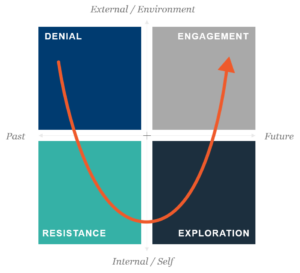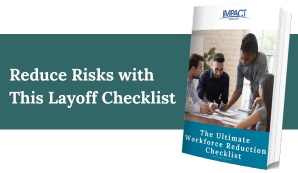Assess each employee’s readiness for change after a layoff
Leading change management can be taxing after a major workforce disruption like a layoff or merger. As a manager, you are vital in helping your remaining employees find a new normal. Start by determining each employee’s readiness for change.
There are four common phases a person goes through when adapting to change:1
- Denial
- Resistance
- Exploration
- Commitment
Employees won’t necessarily move through these phases in a straight line. They may move back and forth between the stages as they progress, and recede, toward creating a new normal.

Knowing which phase your employees are in equips you to best support them. Watch out for these common behaviors.
While in Denial:
Employees in the denial phase are holding out hope that things will go back to how they were. They say things like, “There’s no way this change is going to last. When XYZ happens, I’m sure we will go back to the old way.”
They may also feel worried or anxious because changing their routine makes them uncomfortable. Some will feel paralyzed by not knowing what to do next.
Manager Tip: Over-communicate the new processes and team focus so employees know what is coming. Then assign team members specific tasks and short-term goals so they focus on taking small steps forward.
While in Resistance:
Resistance is a common reaction. Changing routines and long-held habits is very hard. Employees resist change when they are scared, out of their comfort zone, angry about the situation, or don’t possess the needed skills to complete their work.
Manager Tip: Listen and respond to their concerns and fears. Gain their buy-in to create new solutions and solve problems. Offer recognition when someone takes positive steps forward, and consider what the consequences will be if they continue to resist.
While in Exploration:
In this phase, employees begin to try new things. They often take small actions to “test the waters.” They may show increased excitement and flexibility or look for new ways to complete their work. These are all positive steps!
Manager Tip: Be a coach to your employee and praise their efforts, remembering to be mindful of how you correct something that is done wrong. Instead of demotivating them, build on the excitement by asking for their input and involving them in problem-solving the situation.
While in Commitment (or what we refer to as Engagement):
Employees in the engagement phase have accepted and adapted to the change. They will feel comfortable, show confidence, feel successful, and achieve goals.
Manager Tip: Now is the time to create a future vision for the employee and his/her role. Help team members stay goal-oriented and continue to encourage their involvement. Remember to foster an atmosphere of continuous improvement and adaptability with your entire team.
Leading change management when your organization is in flux is a daunting task. Partner with an expert to lead with confidence. Contact us today to learn more about our Leading Through Change program!
1 Scott and Jaffe Change Model, Management Study Guide









